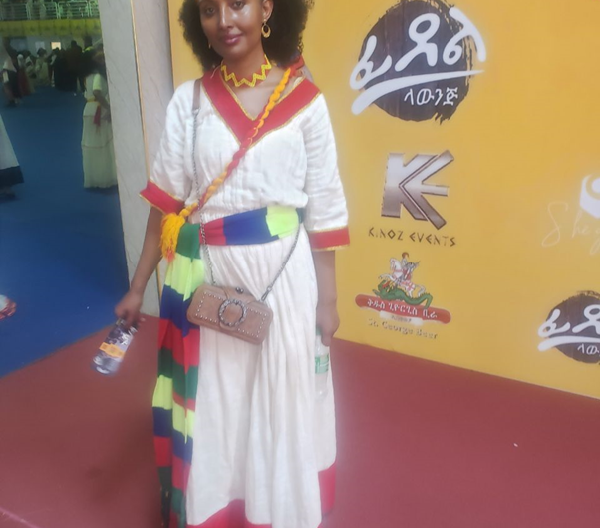
Holding a little variant of names (Ashenda in the majority of Tigray), (Ashendiye in Lalibela), (Shadey in Waghimra), (Solel in Raya) and (Asynewari in Aksum), Ashenda is a young girls’ festival. Ashenda is marked for several weeks in Tigray and Amhara regions right up to the weeks closer to the end of the rainy season, but is officially closed after the end of the two-week fasting season. It is an annual cultural celebration associated with northern Ethiopia, especially the Tigray and Amhara regional states.
The girls and young women, who the festival is for, adorn themselves in dresses called ‘tilfi, which is a cotton dress ornamented on the front with amazing embroidery from the neck to the toe. They also wear their hair in the braided styles that have been developed for ages and ornament themselves with jewelry and Ashenda grass. The length of the festival, which usually takes place between August – September, varies from three days to one month depending on where in the region it takes place: shorter in urban areas, longer in rural areas.
Tigrayan young ladies excitedly anticipate Ashenda, the vibrant celebration, especially when the festival approaches each year. Young girls, young ladies, and particularly teenage girls experience euphoria on this day because it is their freedom day and they are given the go-ahead to spend a week or so singing and dancing out into the streets with friends and peers. In eye-catching costumes, they chant tunes and display their dancing styles to their hearts content.
The Ashenda festival, a vibrant and time-honored cultural event, holds deep significance in Ethiopia’s Tigray region. Celebrated primarily in late August to align with the Ethiopian month of Nehase, the festival brings together young girls and women in an exuberant display of communal songs and dances, fostering a strong sense of community and identity.
Last week, in the heart of Addis Ababa Tigray girls warmly celebrated the Ashenda festival at Millennium Hall in a concert organized by Fidel Lounge. Following the peace deal in Pretoria, the Ashenda festival is colorfully celebrated here in Addis Ababa and Tigray Region as a breath of fresh air and hope of peace is restored in the country after two years of conflict.
‘We did not celebrate Ashenda in Addis Ababa because of the war in the Tigray region, said Mahlet Addis, one of the girls that attended the ceremony at Millennium Hall. At the festival, Tigray girls showed up for the celebration in traditional embroidered dresses and gold jewelry, their hair twisted into elaborate braids and curls beaded headbands.
According to Mahlet, this year’s Ashenda festival is unique because we have put behind our backs the gruesome unfolding during the past couple of years in our country and that is why we are very happy to exercise and showcase our culture after a long hiatus.
Rooted in history, Ashenda traces its origins back to the 4th century, during the rise of Christianity in the ancient city of Aksum. According to some scholars the festival evolved from the story of the Virgin Mary’s ascension into heaven, accompanied by a procession of singing and dancing girls. This original story led to the tradition of girls performing group songs and dances during Ashenda celebrations. The festival’s name itself, “Ashenda,” is derived from the Tigrinya word for a tall green grass used to create decorative skirts worn around the waist.
While Ashenda has deep religious roots, it has grown into a broader cultural tradition over time, transcending religious boundaries. Elements such as women’s attire and jewelry still carry religious symbolism, but the festival now serves as a platform for women and girls to exercise their freedom of expression. Lasting for three days, as determined locally, Ashenda sees girls and women moving door-to-door, celebrating with music and dance. Homeowners typically offer monetary gifts or other tokens, underscoring the festival’s importance in community interactions.
Following a three-year hiatus due to the war, Ashenda’s celebration has resumed this year. Yet, for many Tigrayan women and girls, there is a sober undertone to this year’s festivities. Amidst the grief and trauma inflicted by the conflict, the celebration feels a bit muted.
The Ashenda festival, deeply rooted in history and tradition, holds a unique place in Ethiopia’s Tigray region. Its evolution from religious origins to a broader cultural celebration signifies the resilience and adaptability of this cherished event. However, the conflict in the region has cast a pall over the festivities, underscoring the complex interplay between culture and conflict in shaping the lives of the Tigrayan people. As Ashenda endures, it stands as a testament to the enduring spirit of the community, even in the face of adversity.
The name “Ashenda” came from the name of the tall green grass, estimated at around 80–90 cm minimum height that the girls make into a skirt and wear around their waist as a decoration.
Ashenda girl doesn’t wear common clothes on this much-awaited event; since it is her special day, she would wear a special and colorful cultural dress with unique hairstyles and jewels on her neck, as well as ornaments on her hands, ears, and feet.
From the fact that all girls beautify themselves very carefully, the point is that all the women celebrants are beautiful during Ashenda. After a yearlong busy task, this time of the holiday is all about the girls and having fun. Parents know it is girls’ time and they let them free of any household work.
After the girls get together and beautify themselves with new dresses, fancy hairdos, and jewelry, they take to the streets with a hand drum for three crazy days (in the urban) in groups, chanting different songs specific for that time. They hunt for men, circle around them, and request that to reward them as much as they can demonstrate beautiful cultural songs and dances. They form big groups around the men and dance and sing in order to solicit donations from the guys. There are such songs reserved for those who don’t reward the girls a kind of culturally accepted insult. It is fine as long as you are not in a hurry and have lots of small bills to give out. There is no specific amount as to how much money one can give, one is welcome to give any amount one can.
According to a local publication, the women and girls gather in a central place where they divide themselves into smaller groups before going house-to-house to sing, dance and entertain the people of their community.
It is a unique traditional Tigrayan festival celebrated in northern Ethiopia that is exclusively held for girls and young women. “Ashenda” is the name of a tall grass found in the country that the revelers use to embellish their celebration gowns. The girls dress in lively cultural attire with unique hairstyles and ornamental jewelry. Girls over 13 years of age and who are not married participate in the celebrations.
The celebration of Ashenda could be effectively used to create harmony and friendship among the peoples of Ethiopia and can also provide an excellent opportunity for promoting democracy in the sphere of culture.
Mahlet, explaining the celebration, noted that the fact that we have managed to mark Ashenda with our men counterparts after the bloodshed is heartening. We owe the Almighty gratitude.
Tigrayan people, who suffered a lot are morally strong. They are resilient. They could be exemplary, she added.
She further said that, pertaining to the dressing style, it is predominantly showcasing the ethnic groups in the region.
I was born and brought up here in Addis Ababa. My parents told me Ashenda was a girls’ festival. I learned it is a festival girls participate in when they reach marriageable age.
Though the celebration is meant for young girls, to bequeath the culture to the coming generation, all women from all age groups are partaking in the celebration, she wrapped up
BY NAOL GIRMA
THE ETHIOPIAN HERALD THURSDAY 31 AUGUST 2023





